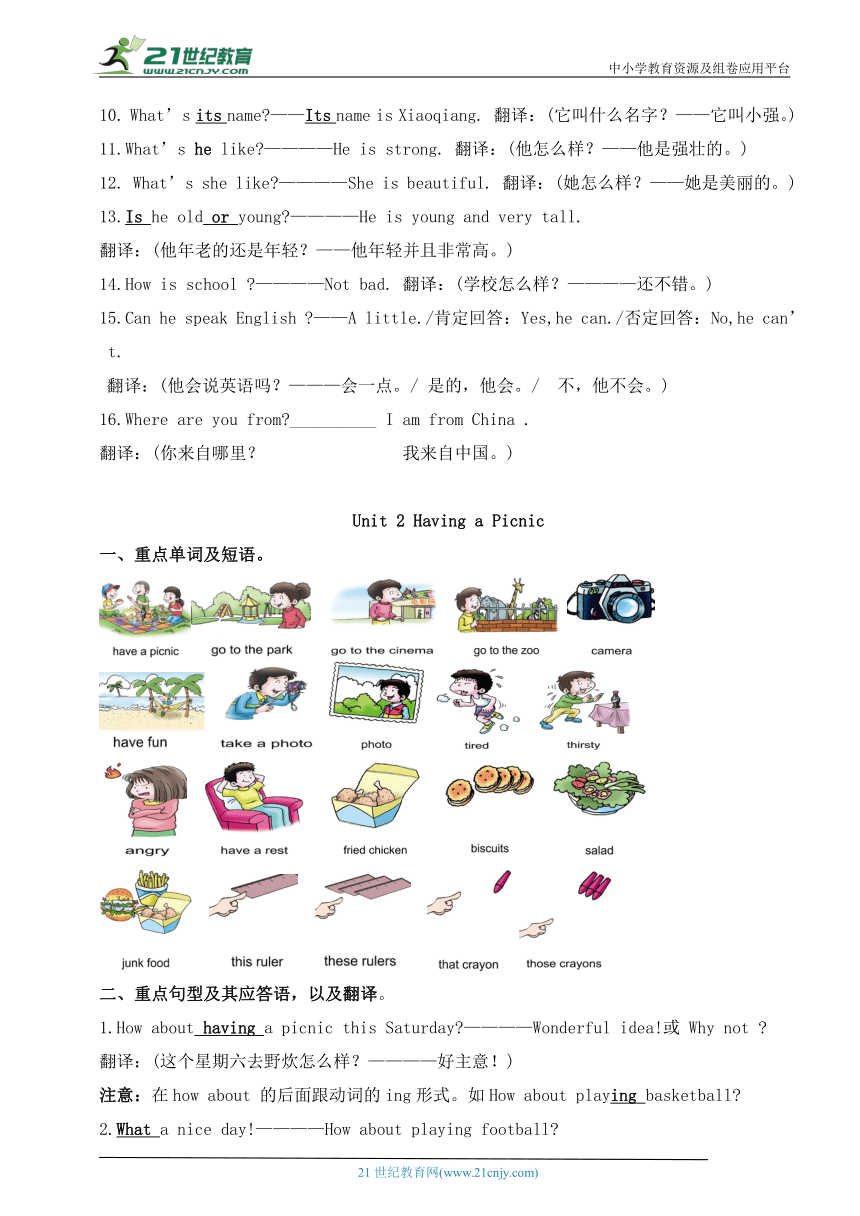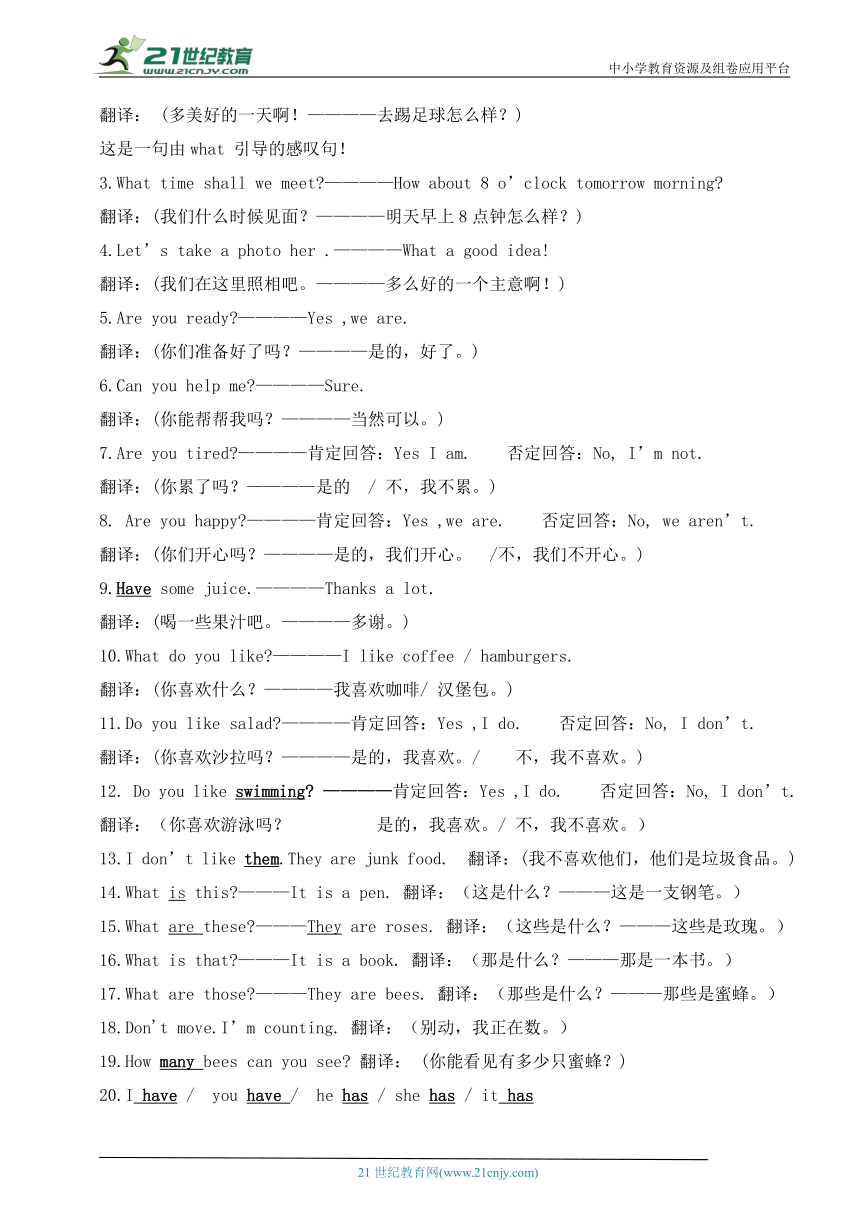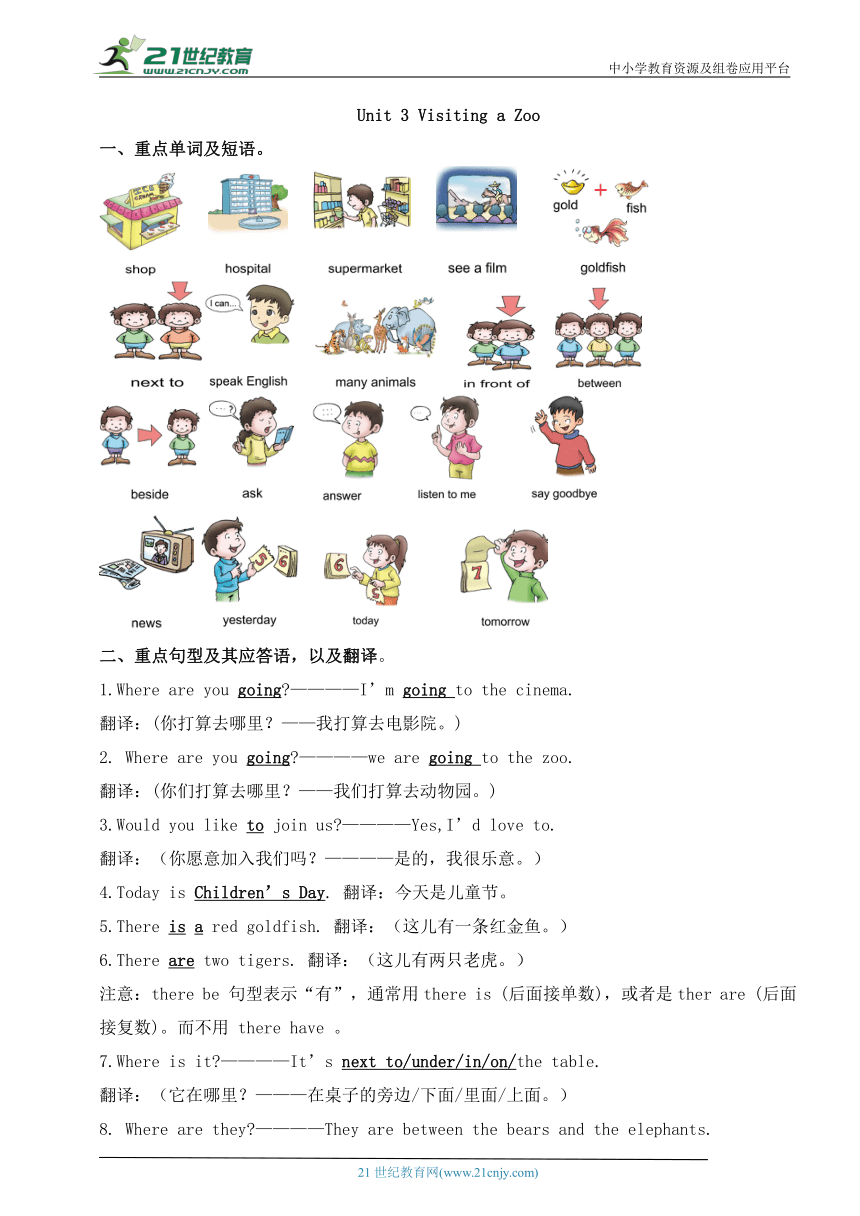川教版本小学四年级下期英语复习知识要点归纳
文档属性
| 名称 | 川教版本小学四年级下期英语复习知识要点归纳 |  | |
| 格式 | doc | ||
| 文件大小 | 9.2MB | ||
| 资源类型 | 试卷 | ||
| 版本资源 | 川教版 | ||
| 科目 | 英语 | ||
| 更新时间 | 2025-06-17 08:17:22 | ||
图片预览




文档简介
中小学教育资源及组卷应用平台
川教版本小学四年级下期英语复习知识要点
Unit 1 Meeting a New Teacher
一、重点单词及短语。
二、重点句型及其应答语,以及翻译。
1.Who is she ——————She is my mum/ teacher.
翻译:(她是谁?————她是我的妈妈 / 老师)
2.How nice to see you again!————Me too.
翻译:(很高兴再次见到你!————我也是。)
3.Let’s say hello to her.————(say hello to……向….问候)注意:这里用介词“to”。)
翻译:(我们向她问好吧。)
4.wash your hair 洗头 wave your arm 挥动手臂 raise your foot 抬脚
touch your eye 摸眼睛 your left hand 你的左手 his short hair 他的短发
5.How are you ————I’m fine. 翻译: (你好吗?————我很好。)
6.What does “clever” mean ————It means “聪明的”.
7.I come from America. 等同于 I’m from America. 翻译:(我来自美国)。
8.What’s his name ————His name is Lele. 翻译:(他叫什么名字?——他叫乐乐。)
9.What’s her name ———Her name is Rose. 翻译:(她叫什么名字?——她叫罗丝。)
10. What’s its name ——Its name is Xiaoqiang. 翻译:(它叫什么名字?——它叫小强。)
11.What’s he like ————He is strong. 翻译:(他怎么样?——他是强壮的。)
12. What’s she like ————She is beautiful. 翻译:(她怎么样?——她是美丽的。)
13.Is he old or young ————He is young and very tall.
翻译:(他年老的还是年轻?——他年轻并且非常高。)
14.How is school ————Not bad. 翻译:(学校怎么样?————还不错。)
15.Can he speak English ——A little./肯定回答:Yes,he can./否定回答:No,he can’t.
翻译:(他会说英语吗?———会一点。/ 是的,他会。/ 不,他不会。)
16.Where are you from __________ I am from China .
翻译:(你来自哪里? 我来自中国。)
Unit 2 Having a Picnic
一、重点单词及短语。
二、重点句型及其应答语,以及翻译。
1.How about having a picnic this Saturday ————Wonderful idea!或 Why not
翻译:(这个星期六去野炊怎么样?————好主意!)
注意:在how about 的后面跟动词的ing形式。如How about playing basketball
2.What a nice day!————How about playing football
翻译: (多美好的一天啊!————去踢足球怎么样?)
这是一句由what 引导的感叹句!
3.What time shall we meet ————How about 8 o’clock tomorrow morning
翻译:(我们什么时候见面?————明天早上8点钟怎么样?)
4.Let’s take a photo her .————What a good idea!
翻译:(我们在这里照相吧。————多么好的一个主意啊!)
5.Are you ready ————Yes ,we are.
翻译:(你们准备好了吗?————是的,好了。)
6.Can you help me ————Sure.
翻译:(你能帮帮我吗?————当然可以。)
7.Are you tired ————肯定回答:Yes I am. 否定回答:No, I’m not.
翻译:(你累了吗?————是的 / 不,我不累。)
8. Are you happy ————肯定回答:Yes ,we are. 否定回答:No, we aren’t.
翻译:(你们开心吗?————是的,我们开心。 /不,我们不开心。)
9.Have some juice.————Thanks a lot.
翻译:(喝一些果汁吧。————多谢。)
10.What do you like ————I like coffee / hamburgers.
翻译:(你喜欢什么?————我喜欢咖啡/ 汉堡包。)
11.Do you like salad ————肯定回答:Yes ,I do. 否定回答:No, I don’t.
翻译:(你喜欢沙拉吗?————是的,我喜欢。/ 不,我不喜欢。)
12. Do you like swimming ————肯定回答:Yes ,I do. 否定回答:No, I don’t. 翻译:(你喜欢游泳吗? 是的,我喜欢。/ 不,我不喜欢。)
13.I don’t like them.They are junk food. 翻译:(我不喜欢他们,他们是垃圾食品。)
14.What is this ———It is a pen. 翻译:(这是什么?———这是一支钢笔。)
15.What are these ———They are roses. 翻译:(这些是什么?———这些是玫瑰。)
16.What is that ———It is a book. 翻译:(那是什么?———那是一本书。)
17.What are those ———They are bees. 翻译:(那些是什么?———那些是蜜蜂。)
18.Don't move.I’m counting. 翻译:(别动,我正在数。)
19.How many bees can you see 翻译: (你能看见有多少只蜜蜂?)
20.I have / you have / he has / she has / it has
Unit 3 Visiting a Zoo
一、重点单词及短语。
二、重点句型及其应答语,以及翻译。
1.Where are you going ————I’m going to the cinema.
翻译:(你打算去哪里?——我打算去电影院。)
2. Where are you going ————we are going to the zoo.
翻译:(你们打算去哪里?——我们打算去动物园。)
3.Would you like to join us ————Yes,I’d love to.
翻译:(你愿意加入我们吗?————是的,我很乐意。)
4.Today is Children’s Day. 翻译:今天是儿童节。
5.There is a red goldfish. 翻译:(这儿有一条红金鱼。)
6.There are two tigers. 翻译:(这儿有两只老虎。)
注意:there be 句型表示“有”,通常用there is (后面接单数),或者是ther are (后面接复数)。而不用 there have 。
7.Where is it ————It’s next to/under/in/on/the table.
翻译:(它在哪里?———在桌子的旁边/下面/里面/上面。)
8. Where are they ————They are between the bears and the elephants.
翻译:(它们在哪里?———他们在熊和大象之间。)
9.What a clever bird! 翻译: (多聪明的一只鸟。)
10.Have you seen them 翻译: (你看见了吗?)
11.Welcome to the dog show. 翻译:(欢迎来欣赏狗狗秀。)
12.What’s 12 plus 15 ———It’s 27. 翻译:(12加15等于几?———— 等于27)
13.What’s 90 minus 30 ———It’s 60. 翻译:(90减30 等于几?———等于60.)
14.Good for you!翻译:(做得好!)
15.Answer my question. 翻译:(回答我的问题。)
16.Can you say it in English ————肯定回答:Yes,I can . 否定回答:No,I can’t.
翻译:(你会用英语来说它吗?———是的,我会。/不,我不会。)
17.What is it ———It’s a car. 翻译:(它是什么?———轿车。)
18.No exam tomorrow. 翻译:(明天没有测试。)
19.Good news. 翻译:(好消息。)
20. How many children are there ————There are five.
翻译:(这里有多少个孩子?———— 这里有五个。)
Unit 4 Enjoying a Birthday
一、重点单词及短语。
二、重点句型及其应答语,以及翻译。
1.You look so happy.Why ————Because today is my sister’s birthday.
翻译:(你看上去非常高兴,为什么?————因为今天是我妹妹的生日。)
2.How old are you ————I’m nine.
翻译:(你多少岁了?————我9岁了。)
3.Happy birthday to you! 翻译:(祝你生日快乐!)
4.What month is it ————It’s June.
翻译:(现在是几月了?————六月。)
5.This is a present for you. ————Oh,it’s a birthday cake! I love it.
翻译:(这是给你的礼物。————噢,是一个生日蛋糕,我喜欢它。)
6.You look great. 翻译:(你看起来很漂亮。)
7.When is your birthday ————It’s in May.
翻译:(你的生日的什么时候? ————五月。)
8.How about yours 翻译:(你的呢?)
9.This is a birthday present from my mum. 翻译:(这是我妈妈送给我的生日礼物。)
10.Draw a circle. 翻译:(画一个圆。)
11.Colour the circle. 翻译:(给圆涂色。)
12.Cut it out. 翻译:(把它剪下来。)
13.Cut on the line. 翻译:(沿线剪开。)
14.Fold it like this. 翻译:(像这样折叠。)
15.Glue it. 翻译:(把它粘在一起。)
16. I want a balloon. 翻译:(我想要一个气球。)
17. I want some apples. 翻译:(我想要一些苹果。)
18.Let me tell you a joke.————What is it
翻译:(让我给你讲个笑话。————是什么笑话?)
19.The joke is about a boy and his mom..
翻译:(这个笑话是关于一个男孩和他的妈妈。)
20.What do you want ————I want a pen.
翻译:(你想要什么?————我想要一支钢笔。)
小学英语26个字母标准手写体
总结:26个大写字母基本上只占四线三格纸中的上面两格;
小写字母a、c、e、m、n、o、r、s、u、v、w、x、z只占中间一格;
小写字母f占满三格;
小写字母b、d、h、i、k、l、t占上两格;
小写字母g、p、q、y占下两格;
小写字母j占满下面两格,最上面的那格占一半。
小学英语常见标点符号写法
英语大写字母的应用
1.句子开头的第一个字母要大写。
例:This is a present for you.
2.字母 I 作为一个单词表示“我”时,在句中任何位置都要大写。
例:Can I help you
3. 表示地名、国名和人名等专有名词的第一个字母要大写。
例:Chengdu (成都)、American(美国)、China (中国)、Mike (麦克)、Ting ting(婷婷)
Le Le(乐乐)、Rose(罗丝)
4.星期、月份名称的第一个字母要大写,但季节第一个字母不大写;。
例:Sunday(星期天)、August(八月)、winter(冬天)、spring(春天)
5.表示节日名称的单词的第一字母都要大写。
例:Children’s Day (儿童节)、National Day( 国庆节)、Teachers ' Day(教师节)
6.表示称呼语或职务的单词的第一个字母要大写。
例:Ms Chen (陈老师)、Mr Bright (布莱特先生)、Miss s u (苏老师)
7.大多数的缩略词要大写。
例:CCTV(中国中央电视台)、ID(身份证)、CD(光盘)、WTO(世界贸易组织)、
UFO(不明飞行物)、UK(英国)、USA(美国)
21世纪教育网 www.21cnjy.com 精品试卷·第 2 页 (共 2 页)
HYPERLINK "http://21世纪教育网(www.21cnjy.com)
" 21世纪教育网(www.21cnjy.com)
川教版本小学四年级下期英语复习知识要点
Unit 1 Meeting a New Teacher
一、重点单词及短语。
二、重点句型及其应答语,以及翻译。
1.Who is she ——————She is my mum/ teacher.
翻译:(她是谁?————她是我的妈妈 / 老师)
2.How nice to see you again!————Me too.
翻译:(很高兴再次见到你!————我也是。)
3.Let’s say hello to her.————(say hello to……向….问候)注意:这里用介词“to”。)
翻译:(我们向她问好吧。)
4.wash your hair 洗头 wave your arm 挥动手臂 raise your foot 抬脚
touch your eye 摸眼睛 your left hand 你的左手 his short hair 他的短发
5.How are you ————I’m fine. 翻译: (你好吗?————我很好。)
6.What does “clever” mean ————It means “聪明的”.
7.I come from America. 等同于 I’m from America. 翻译:(我来自美国)。
8.What’s his name ————His name is Lele. 翻译:(他叫什么名字?——他叫乐乐。)
9.What’s her name ———Her name is Rose. 翻译:(她叫什么名字?——她叫罗丝。)
10. What’s its name ——Its name is Xiaoqiang. 翻译:(它叫什么名字?——它叫小强。)
11.What’s he like ————He is strong. 翻译:(他怎么样?——他是强壮的。)
12. What’s she like ————She is beautiful. 翻译:(她怎么样?——她是美丽的。)
13.Is he old or young ————He is young and very tall.
翻译:(他年老的还是年轻?——他年轻并且非常高。)
14.How is school ————Not bad. 翻译:(学校怎么样?————还不错。)
15.Can he speak English ——A little./肯定回答:Yes,he can./否定回答:No,he can’t.
翻译:(他会说英语吗?———会一点。/ 是的,他会。/ 不,他不会。)
16.Where are you from __________ I am from China .
翻译:(你来自哪里? 我来自中国。)
Unit 2 Having a Picnic
一、重点单词及短语。
二、重点句型及其应答语,以及翻译。
1.How about having a picnic this Saturday ————Wonderful idea!或 Why not
翻译:(这个星期六去野炊怎么样?————好主意!)
注意:在how about 的后面跟动词的ing形式。如How about playing basketball
2.What a nice day!————How about playing football
翻译: (多美好的一天啊!————去踢足球怎么样?)
这是一句由what 引导的感叹句!
3.What time shall we meet ————How about 8 o’clock tomorrow morning
翻译:(我们什么时候见面?————明天早上8点钟怎么样?)
4.Let’s take a photo her .————What a good idea!
翻译:(我们在这里照相吧。————多么好的一个主意啊!)
5.Are you ready ————Yes ,we are.
翻译:(你们准备好了吗?————是的,好了。)
6.Can you help me ————Sure.
翻译:(你能帮帮我吗?————当然可以。)
7.Are you tired ————肯定回答:Yes I am. 否定回答:No, I’m not.
翻译:(你累了吗?————是的 / 不,我不累。)
8. Are you happy ————肯定回答:Yes ,we are. 否定回答:No, we aren’t.
翻译:(你们开心吗?————是的,我们开心。 /不,我们不开心。)
9.Have some juice.————Thanks a lot.
翻译:(喝一些果汁吧。————多谢。)
10.What do you like ————I like coffee / hamburgers.
翻译:(你喜欢什么?————我喜欢咖啡/ 汉堡包。)
11.Do you like salad ————肯定回答:Yes ,I do. 否定回答:No, I don’t.
翻译:(你喜欢沙拉吗?————是的,我喜欢。/ 不,我不喜欢。)
12. Do you like swimming ————肯定回答:Yes ,I do. 否定回答:No, I don’t. 翻译:(你喜欢游泳吗? 是的,我喜欢。/ 不,我不喜欢。)
13.I don’t like them.They are junk food. 翻译:(我不喜欢他们,他们是垃圾食品。)
14.What is this ———It is a pen. 翻译:(这是什么?———这是一支钢笔。)
15.What are these ———They are roses. 翻译:(这些是什么?———这些是玫瑰。)
16.What is that ———It is a book. 翻译:(那是什么?———那是一本书。)
17.What are those ———They are bees. 翻译:(那些是什么?———那些是蜜蜂。)
18.Don't move.I’m counting. 翻译:(别动,我正在数。)
19.How many bees can you see 翻译: (你能看见有多少只蜜蜂?)
20.I have / you have / he has / she has / it has
Unit 3 Visiting a Zoo
一、重点单词及短语。
二、重点句型及其应答语,以及翻译。
1.Where are you going ————I’m going to the cinema.
翻译:(你打算去哪里?——我打算去电影院。)
2. Where are you going ————we are going to the zoo.
翻译:(你们打算去哪里?——我们打算去动物园。)
3.Would you like to join us ————Yes,I’d love to.
翻译:(你愿意加入我们吗?————是的,我很乐意。)
4.Today is Children’s Day. 翻译:今天是儿童节。
5.There is a red goldfish. 翻译:(这儿有一条红金鱼。)
6.There are two tigers. 翻译:(这儿有两只老虎。)
注意:there be 句型表示“有”,通常用there is (后面接单数),或者是ther are (后面接复数)。而不用 there have 。
7.Where is it ————It’s next to/under/in/on/the table.
翻译:(它在哪里?———在桌子的旁边/下面/里面/上面。)
8. Where are they ————They are between the bears and the elephants.
翻译:(它们在哪里?———他们在熊和大象之间。)
9.What a clever bird! 翻译: (多聪明的一只鸟。)
10.Have you seen them 翻译: (你看见了吗?)
11.Welcome to the dog show. 翻译:(欢迎来欣赏狗狗秀。)
12.What’s 12 plus 15 ———It’s 27. 翻译:(12加15等于几?———— 等于27)
13.What’s 90 minus 30 ———It’s 60. 翻译:(90减30 等于几?———等于60.)
14.Good for you!翻译:(做得好!)
15.Answer my question. 翻译:(回答我的问题。)
16.Can you say it in English ————肯定回答:Yes,I can . 否定回答:No,I can’t.
翻译:(你会用英语来说它吗?———是的,我会。/不,我不会。)
17.What is it ———It’s a car. 翻译:(它是什么?———轿车。)
18.No exam tomorrow. 翻译:(明天没有测试。)
19.Good news. 翻译:(好消息。)
20. How many children are there ————There are five.
翻译:(这里有多少个孩子?———— 这里有五个。)
Unit 4 Enjoying a Birthday
一、重点单词及短语。
二、重点句型及其应答语,以及翻译。
1.You look so happy.Why ————Because today is my sister’s birthday.
翻译:(你看上去非常高兴,为什么?————因为今天是我妹妹的生日。)
2.How old are you ————I’m nine.
翻译:(你多少岁了?————我9岁了。)
3.Happy birthday to you! 翻译:(祝你生日快乐!)
4.What month is it ————It’s June.
翻译:(现在是几月了?————六月。)
5.This is a present for you. ————Oh,it’s a birthday cake! I love it.
翻译:(这是给你的礼物。————噢,是一个生日蛋糕,我喜欢它。)
6.You look great. 翻译:(你看起来很漂亮。)
7.When is your birthday ————It’s in May.
翻译:(你的生日的什么时候? ————五月。)
8.How about yours 翻译:(你的呢?)
9.This is a birthday present from my mum. 翻译:(这是我妈妈送给我的生日礼物。)
10.Draw a circle. 翻译:(画一个圆。)
11.Colour the circle. 翻译:(给圆涂色。)
12.Cut it out. 翻译:(把它剪下来。)
13.Cut on the line. 翻译:(沿线剪开。)
14.Fold it like this. 翻译:(像这样折叠。)
15.Glue it. 翻译:(把它粘在一起。)
16. I want a balloon. 翻译:(我想要一个气球。)
17. I want some apples. 翻译:(我想要一些苹果。)
18.Let me tell you a joke.————What is it
翻译:(让我给你讲个笑话。————是什么笑话?)
19.The joke is about a boy and his mom..
翻译:(这个笑话是关于一个男孩和他的妈妈。)
20.What do you want ————I want a pen.
翻译:(你想要什么?————我想要一支钢笔。)
小学英语26个字母标准手写体
总结:26个大写字母基本上只占四线三格纸中的上面两格;
小写字母a、c、e、m、n、o、r、s、u、v、w、x、z只占中间一格;
小写字母f占满三格;
小写字母b、d、h、i、k、l、t占上两格;
小写字母g、p、q、y占下两格;
小写字母j占满下面两格,最上面的那格占一半。
小学英语常见标点符号写法
英语大写字母的应用
1.句子开头的第一个字母要大写。
例:This is a present for you.
2.字母 I 作为一个单词表示“我”时,在句中任何位置都要大写。
例:Can I help you
3. 表示地名、国名和人名等专有名词的第一个字母要大写。
例:Chengdu (成都)、American(美国)、China (中国)、Mike (麦克)、Ting ting(婷婷)
Le Le(乐乐)、Rose(罗丝)
4.星期、月份名称的第一个字母要大写,但季节第一个字母不大写;。
例:Sunday(星期天)、August(八月)、winter(冬天)、spring(春天)
5.表示节日名称的单词的第一字母都要大写。
例:Children’s Day (儿童节)、National Day( 国庆节)、Teachers ' Day(教师节)
6.表示称呼语或职务的单词的第一个字母要大写。
例:Ms Chen (陈老师)、Mr Bright (布莱特先生)、Miss s u (苏老师)
7.大多数的缩略词要大写。
例:CCTV(中国中央电视台)、ID(身份证)、CD(光盘)、WTO(世界贸易组织)、
UFO(不明飞行物)、UK(英国)、USA(美国)
21世纪教育网 www.21cnjy.com 精品试卷·第 2 页 (共 2 页)
HYPERLINK "http://21世纪教育网(www.21cnjy.com)
" 21世纪教育网(www.21cnjy.com)
同课章节目录
